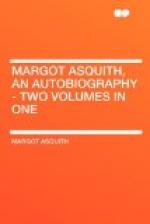I will digress here to explain our after-dinner games. There were several, but the best were what Laura and I invented: one was called “Styles,” another “Clumps”—better known as “Animal, Vegetable or Mineral”—a third, “Epigrams” and the most dangerous of all “Character Sketches.” We were given no time-limit, but sat feverishly silent in different corners of the room, writing as hard as we could. When it was agreed that we had all written enough, the manuscripts were given to our umpire, who read them out loud. Votes were then taken as to the authorship, which led to first-rate general conversation on books, people and manner of writing. We have many interesting umpires, beginning with Bret Harte and Laurence Oliphant and going on to Arthur Balfour, George Curzon, George Wyndham, Lionel Tennyson, [Footnote: Brother of the present Lord Tennyson.] Harry Cust and Doll Liddell: all good writers themselves.
Some of our guests preferred making caricatures to competing in the more ambitious line of literature. I made a drawing of the Dowager Countess of Aylesbury, better known as “Lady A.”; Colonel Saunderson—a famous Orangeman—did a sketch of Gladstone for me; while Alma Tadema gave me one of Queen Victoria, done in four lines.
These games were good for our tempers and a fine training; any loose vanity, jealousy, or over-competitiveness were certain to be shown up; and those who took the buttons off the foils in the duel of argument—of which I have seen a good deal in my life—were instantly found out. We played all our games with much greater precision and care than they are played now and from practice became extremely good at them. I never saw a playing-card at Glen till after I married, though—when we were obliged to dine downstairs to prevent the company being thirteen at dinner—I vaguely remember a back view of my grandpapa at the card-table playing whist.
Laura was a year and a half older than I was and came out in 1881, while I was in Dresden. The first party that she and I went to together was a political crush given by Sir William and Lady Harcourt. I was introduced to Spencer Lyttleton and shortly after this Laura met his brother Alfred.
One day, as she and I were leaving St. Paul’s Cathedral, she pointed out a young man to me and said:
“Go and ask Alfred Lyttelton to come to Glen any time this autumn,” which I promptly did.
The advent of Alfred into our family coincided with that of several new men, the Charterises, Balfours, George Curzon, George Wyndham, Harry Cust, the Crawleys, Jack Pease, “Harry” Paulton, Lord Houghton, Mark Napier, Doll Liddell and others. High hopes had been entertained by my father that some of these young men might marry us, but after the reception we gave to Lord Lymington —who, to do him justice, never proposed to any of us except in the paternal imagination—his nerve was shattered and we were left to ourselves.




